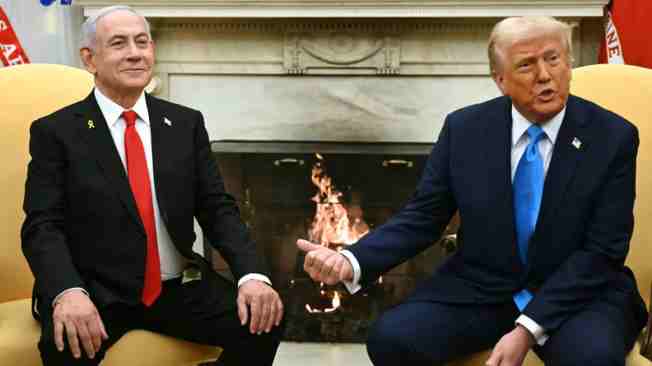U.S. President Donald Trump hosted Israeli Prime Minister Benjamin Netanyahu at the White House on Monday for a high-level dinner where the two leaders discussed ongoing efforts to end the war in Gaza, revive dialogue with Iran, and explore controversial options for relocating Palestinians from the besieged enclave.
Addressing reporters before the dinner, Netanyahu suggested that the U.S. and Israel were collaborating with other nations willing to offer Palestinians what he called a “better future.” He floated the idea that Gaza’s residents should have the option to leave if they choose.
“If they wish to stay, that’s their right,” Netanyahu said. “But if they want to leave, we’re working with the U.S. and a few other countries to make that possible.”
Trump, initially cautious when questioned about the relocation plan, later noted strong regional support. “We've had tremendous cooperation from neighboring countries every one of them. Something positive is coming,” he said.
Earlier this year, Trump proposed transforming Gaza into a Mediterranean resort hub the “Riviera of the Middle East” a suggestion that drew fierce backlash from Palestinians and condemnation from human rights organizations, which labeled it an attempt at ethnic cleansing.
The meeting in Washington occurred as indirect negotiations continued between Israel and Hamas, mediated by the U.S. in Qatar.
Netanyahu was expected to meet Vice President JD Vance on Tuesday and to hold talks with congressional leaders later in the day.
Trump expressed optimism about reaching a ceasefire deal soon, echoing Netanyahu’s comments before his U.S. trip that ongoing talks in Doha could benefit from American engagement. This marks the third in-person meeting between the two leaders since Trump returned to office in January.
Their latest engagement came on the heels of a dramatic escalation: Trump had recently ordered airstrikes on Iranian nuclear facilities in support of Israeli attacks, a conflict that ended in a 12-day war and a brokered ceasefire.
Now, Trump’s administration is preparing to enter talks with Iran. “We’ve scheduled discussions with Iran they want to talk,” Trump said, adding that sanctions could be lifted “at the right time.”
Iran’s President Masoud Pezeshkian, in a separate interview released Monday, signaled that Tehran was open to resolving its differences with Washington through dialogue.
The White House is attempting to use the fallout from Iran’s military losses which supports Hamas to generate momentum toward ending the Gaza conflict. Trump and Netanyahu held their private discussions in the Blue Room, breaking from the tradition of formal meetings in the Oval Office.
Outside, protests erupted near the White House as demonstrators waved Palestinian flags and banners calling for an end to U.S. military support for Israel. Some demanded Netanyahu’s arrest over alleged war crimes in Gaza, referencing the International Criminal Court’s warrant against him.
Before the White House meeting, Netanyahu met with Secretary of State Marco Rubio and Trump’s Middle East envoy, Steve Witkoff. Netanyahu also handed Trump a letter nominating him for the Nobel Peace Prize, a gesture Trump appeared to welcome.
As negotiations in Doha continue, Israel hopes its confrontation with Iran will strengthen efforts to normalize relations with countries like Saudi Arabia, Lebanon, and Syria. Witkoff, who helped shape the U.S.-backed 60-day ceasefire proposal currently under discussion, is set to join the Qatar talks this week.
Still, major hurdles remain. Palestinian sources told Reuters that the primary sticking point is Israel’s continued restriction on humanitarian aid into Gaza. While Israel claims it is facilitating food deliveries, it also insists on measures to prevent militant groups from diverting supplies.
The second day of indirect talks involved one formal session, with more expected later in the evening. The ceasefire framework on the table includes a phased release of hostages, Israeli troop withdrawals from specific areas in Gaza, and negotiations to bring an end to the war.
However, the two sides remain divided on core issues: Hamas demands a permanent halt to hostilities before any further hostage releases, while Israel insists fighting will continue until all hostages are returned and Hamas is dismantled.
Trump, speaking last week, said he would press Netanyahu to accelerate a Gaza agreement, and emphasized that the Israeli leader is also keen to bring the conflict to a close.
Although Netanyahu faces resistance from some members of his right-wing coalition who oppose ending the military campaign, growing public frustration in Israel may push his government to accept a ceasefire under favorable terms.
A previous truce collapsed in March, and efforts to revive it have so far failed. In the meantime, Israel’s intensified military operations have severely disrupted food distribution in Gaza, where nearly half a million people are on the brink of famine, according to the United Nations.
Displaced residents in Gaza are closely monitoring the negotiations. “We ask the mediators to do everything they can,” said Abu Suleiman Qadoum, who fled his home in Gaza City. “We can’t bear this anymore.”
The war began in October 2023 when Hamas launched a deadly cross-border attack into southern Israel, killing around 1,200 people and taking 251 hostages. About 50 hostages are believed to remain in Gaza, with 20 possibly still alive.
Israel’s military campaign in response has killed over 57,000 Palestinians, according to Gaza’s health authorities. The vast majority of Gaza’s population has been displaced.
Trump has remained a staunch backer of Netanyahu and even weighed in on his ongoing legal battles, criticizing Israeli prosecutors pursuing corruption charges that Netanyahu continues to deny.

